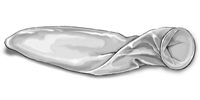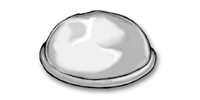The only way that you can be protected against STIs (sexually transmitted infections ) is by using condoms and dental dams.
A diaphragm is inserted inside the vagina to stop sperm from getting in. They do not protect against STIs.
The male condom
The male condom is a fine rubber (latex) or synthetic sheath that is worn on an erect (stiff) penis. It collects the sperm and stops them entering the vagina and uterus.

How well does it work?
Condoms are 98 per cent effective with perfect use. Almost two in ten women (18 per cent) will still get pregnant using condoms, generally because the condoms are not used properly. Condoms are not as effective as the Pill, IUD (Intra Uterine Device), the contraceptive injection (Depo Provera or Depo Ralovera) or the Contraceptive Skin Implant.
You must use a new one every time you have sex and take care to put it on and take it off correctly. A water-based lubricant should be used every time you use a condom as this reduces the risk of the condom breaking. Condoms are for single use only.
Side effects
None, unless you or your partner are allergic to latex rubber or to the lubricant. Allergies to synthetic condoms are extremely rare.
Advantages
- Reduces the risk of pregnancy and sexually transmitted infections (STIs), including HIV/AIDS.
- They can be purchased over-the-counter at chemists and supermarkets. You do not need a prescription.
Disadvantages
The material used in male condoms is perishable so they need to be kept in a cool place and used before the expiry date. Oil-based lubricants such as petroleum jelly and massage oil should not be used with latex rubber condoms since these products increase the risk of the condom breaking.
Dental Dam
A dental dam is a rectangular sheet of latex used to cover the vulva during oral sex. A dental dam will protect against STIs, which can be transmitted during oral sex if there is not protection used. If you don't have a dental dam on hand during sex it is possible to cut a condom open so that it can be used to as a dental dam.
The female condom
The female condom is a pre-lubricated sheath that fits loosely into the vagina. A soft removable ring helps to insert it as well as keeping the condom in place. A large flexible ring remains on the outside of the vagina, covering the opening of the vagina (vulva), providing added protection.
Female condoms are 95 per cent effective with perfect use. Approximately two in ten women (20 per cent) will still get pregnant using a female condom, usually because the condom is not used properly.
They are made of polyurethane and are pre-lubricated with a silicone-based lubricant. Oil-based lubricant can be used with the female condom. Condoms are for single use only; you must use a new one every time you have sex. The female condom cannot be used with a male condom because this can cause it to move out of place.
Side effects
None, unless you are allergic to polyurethane or the lubricant. This is very rare.
Advantages
- Can be inserted before sex and does not need to be removed immediately after intercourse.
- Reduces the risk of pregnancy and STIs.
- No need to see a doctor to get them.
Diaphragms
These are soft silicone caps worn inside the vagina to cover the cervix (the entrance to the uterus). They prevent the sperm entering the uterus.

How well they work
For a diaphragm to work it needs to fit properly, to be put in correctly and to be used every time you have sex. They are 94 per cent effective with perfect use but typically they are not used perfectly and around two in ten women or 18 per cent, will still get pregnant.
Advantages
- You only have to use them when you have sex.
- Can be used when you have your period (menstruate).
- Can be washed and used again and last for one to two years.
Disadvantages
- You have to put them in before you have sex (they can be inserted up to 24 hours before) and remove them after six hours.
- Some women may find them difficult to insert.
- Do not prevent sexually transmitted infections (STIs).
Where to get more information
- Your local doctor (GP)
- Your local pharmacist
- Women’s Welcome Centre (Victoria only)
Tel: (03) 8345 3037 or 1800 442 007 (rural callers)
Fact sheets about the different types of contraception are also available in Arabic, Chinese, Hindi, Spanish, Urdu and Vietnamese – see Related Health Topics below.
Related information
- Sexual Health Victoria for more information on contraception
- Provide feedback about the information on this page
Disclaimer
The Women’s does not accept any liability to any person for the information or advice (or use of such information or advice) which is provided on the Website or incorporated into it by reference. The Women’s provide this information on the understanding that all persons accessing it take responsibility for assessing its relevance and accuracy. Women are encouraged to discuss their health needs with a health practitioner. If you have concerns about your health, you should seek advice from your health care provider or if you require urgent care you should go to the nearest Emergency Dept.